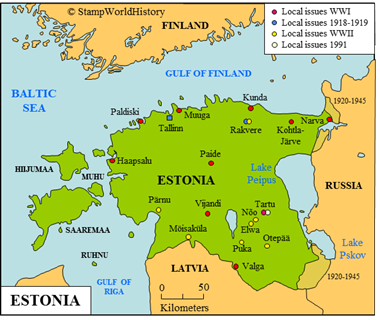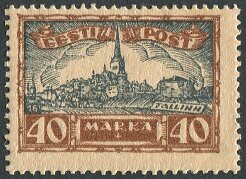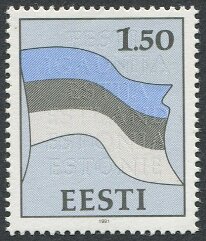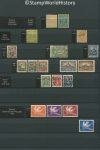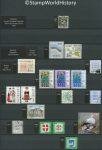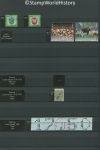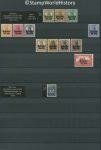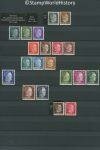
Estonia
Quick reference
General issues: Republic 1918-1940, Soviet Socialist Republic 1940, Soviet Socialist Republic within the Soviet Union 1940, Republic 1991-Present
Country name on general issues: Eesti
Special issues:
- Occupation issues WWI
- Oberbefehlshaber Ost
- Local issues Tartu 1918
- Local issues Rakvere 1918, Tallinn 1919
- Occupation issues WWII
- Estonia 1941
- Local issues 1941 Elwa, Möisaküla, Nöo, Otepää, Pärnu, Puko, Rakvere
- Reichskommissariat Ostland 1941-1944
- Local issues Tartu 1991
Currency: 1 Ruble = 100 Kopeks 1918, 1 Mark =100 Penni 1919-1928, 1 Krone = 100 Senti 1928-1940, 1 Ruble = 100 Kopeks 1991-1992, 1 Krone = 100 Senti 1992-2014, 1 Euro = 100 Eurocent 2011-Present
Population: 1 089 000 in 1922, 1 258 000 in 2016
Political history Estonia
Estonia in the Russian empire
Estonia is one of the Baltic states located in northern Europe. In the early 18th century, Estonia became part of the Russian empire. The Estonians are a Finnic people – an ethnic minority in the Russian empire. Estonia formed one of the governates[1]In imperial Russia, a governate was the administrative level just below the national level. of the Russian empire and comprised only part of modern day Estonia. In 1917, the northern part of the neighboring governate of Livonia – which had a majority Estonian population – was attached to the governate of Estonia. Thus, the borders of Estonia as we know them today were established. Although Estonians were the majority of the population, Baltic Germans[2]Germans had settled in the Baltics since the 12th century and gradually grown to be the elite in Baltic societies. formed an elite in Estonian society. Estonian nationalism developed in the 19th century.
The Russian Revolution and WWI
The 1917 October Revolution brought the Bolsheviks to power in Russia. Civil war ensued and ethnic minorities proclaimed independence across the Russian empire. Estonia proclaimed independence as the republic of Estonia in February 1918. Independence was short lived. Germany, as part of the WWI offensive against Russia in 1918, occupied Estonia the month independence was declared.[3]Prior to the occupation of the mainland, Germany had occupied the island of Ruhnu in 1915, and the islands of Hijuma, Muhu and Saaremaa in 1917. Estonia, subsequently, was under German military administration as part of the area administered by the ‘Oberbefehlshaber Ost’.[4]The Oberbefehlshaber Ost was the supreme commander of the German forces on the Russian front during WWI. For a map of the area controlled by the Oberbefehlshaber Ost, please refer to the map of Germany 1914-1938. . When WWI ended with the German capitulation in November 1918, the administration was transferred to a provisional government. A constitutional government was installed in April 1919.
Estonian War of Independence
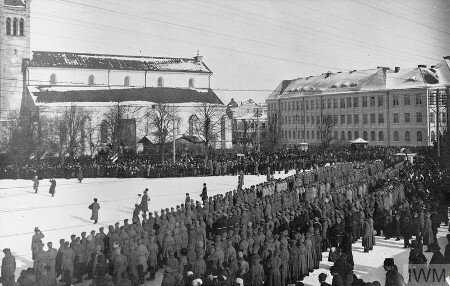
Parade of the Estonian army in the capital, Tallinn, in February 1919.
Following the retreat of the German forces, the Estonian War of Independence ensued. A war that was intertwined with the Russian Civil War. The Russian Civil War was fought between the Bolsheviks – the Reds – and those that opposed the Bolsheviks – the Whites. In November 1918, Red Russian forces invaded Estonia. Estonian and White Russian forces, that were building up in Estonia, drove back the Red Russian forces and, in May 1919, crossed the Russian border to push the defense lines further east. In May 1919, Estonian forces also moved into Latvia to play a significant part in the Latvian War of Independence.
The White Russian forces in Estonia, in July 1919, formed the White Russian ‘Army of the Northwest’, led by general Nikolai Yudenich. From Estonia, with British and Estonian support, the Army of the Northwest launched an offensive against the Reds in September 1919 to gain St. Petersburg. The offensive ended in defeat for the Army of the Northwest that was, subsequently, dissolved.
The Estonian War of Independence ended with the Treaty of Tartu, signed in February 1920 between Estonia and Russia, in which Russia recognized Estonian independence. By way of the treaty, the Estonian border was adjusted to include part of the territory Estonia controlled since May 1919. International recognition soon followed.
The interwar period and WWII
Independent Estonia was governed as a parliamentary republic with governments rapidly succeeding each other. In 1934, by way of a coup, parliament was dissolved and the country was ruled by decree until 1938, when democracy was restored. In the interwar period, one of the main changes was the transfer of the vast land holdings of Baltic Germans to Estonian farmers.
In 1939, Germany and the Soviet Union signed the Molotov-Ribbentrop Pact defining their respective spheres of interest in eastern Europe. Russia, subsequently, invaded Estonia in June 1940. In July 1940, the Estonian Soviet Socialist Republic was formed, that, in August 1940, was annexed to the Soviet Union. Soviet rule would last a year. In June 1941, Germany invaded the Soviet Union and occupied Estonia from July to August 1941. After a period of military administration, Estonia came under civil administration, in December 1941, as part of the ‘Reichskommissariat Ostland’.[5]The Reichskommissariat Osland included the Baltic states and parts of Poland and Belarus. For a map of the area administered by the Reichskommissariat Ostland, please refer to the map of Germany 1938-1945. As the tables turned in WWII, the Soviet Union drove back the German forces and Estonia was regained by the Soviet Union in September 1944.
The Estonian Soviet Socialist Republic
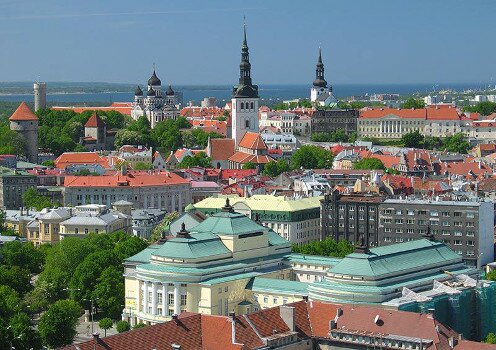
Tallinn, today, is home to one third of the population of Estonia.
Reestablished as the Estonian Soviet Socialist Republic, Estonia was now fully integrated into the Soviet Union. In 1945 the border was adjusted to the pre 1920 border. Resistance against Soviet rule was quenched by the early 1950’s and significant numbers of Estonians were deported. Although de jure an independent state with its own governmental institutions, de facto Estonia was ruled from the Kremlin in Moscow. Private holdings were nationalized and collectivized. Ethnic Russians settled in Estonia, thus changing the demographics of the country.
The 1980’s brought liberalization. Political parties were formed which asserted Estonian identity. In the late 1980’s mass demonstrations called for independence. The Estonian parliament changed the designation of Estonia from ‘Soviet Socialist Republic’ to ‘Republic’ in 1990. When the Soviet Union broke up in 1991, full independence was gained.
Independent Estonia to date
Independent Estonia has been a stable parliamentary democracy until today. While many of the former parts of the Soviet Union stayed closely affiliated with the Russian Federation in the Commonwealth of Independent States, Estonia turned west – as did the other Baltic states. Estonia joined NATO in March 2004 and the European Union in May 2004.
Economically, Estonia has, since independence, developed into a fast growing free market economy. Services are the largest sector in the economy – telecommunications and information technology being an important sub sector. On the United Nations Human Development Index, Estonia ranks as a Very High Development country. The population was 88% Estonian before WWII. Today, the population is 69% Estonian and 25% Russian. The large Russian minority causes frictions in Estonia – and with Russia.
Postal history Estonia
The stamps of imperial Russia were used in Estonia until 1918. These were, during the WWI occupation by Germany, superseded by the issues of the German Oberbefehlshaber Ost – German stamps overprinted ‘Postgebiet Ob. Ost'[6]‘Postal area Ob. Ost’ . During German occupation, local issues appeared for use in Tartu[7]Also known as Dorpat. – Russian stamps overprinted with new face values in the German currency.
The republic of Estonia issued its first stamps in November 1918 – in the Russian currency. Stamps in the Estonian currency first appeared in January 1919. In these early days of the republic, local issues appeared in Rakvere in November 1918 and in Tallinn[8]Also knwon as Reval in May 1919 – both issues being Russian stamps with overprints.[9]The Tallinn issues were available only in Tallinn, but valid for use throughout Estonia. The independent republic of Estonia issued stamps until 1940. After the Soviet invasion, initially, stamps continued to be issued with the designation ‘Eesti Post’. The Estonian Soviet Socialist Republic issued one set of stamps in July 1940. The last issue with the designation ‘Eesti Post’ appeared in August 1940, just after the annexation by the Soviet Union.[10]An additional value to a set of definitives first issued in 1928. The stamps with the designation ‘Eesti Post’ were, subsequently, superseded by the stamps of the Soviet Union.[11]Resources indicate that Soviet stamps were introduced in June 1940, while the issues designated ‘Eesti Post’ remained valid until early 1941 – different dates in early 1941 are mentioned for the demonitization.
Under German occupation during WWII, initially, the stamps of Germany were used without overprint. In August and September 1941, stamps were issued for use in Estonia with the designation ‘Estland – Eesti’. Local issues appeared in several cities during the first months of German occupation.[12]The Michel catalog lists issues for Elwa, Möisaküla, Nöo, Otepää and Pärnu. Yvert & Tellier refers to these cities and also to issues of the cities of Puko and Rakvere. From November 1941, the stamps issued by the Reichskommissariat Ostland were brought into circulation – German stamps overprinted Ostland. German stamps without overprint remained valid for use throughout the German occupation, although they were only available from post offices until the introduction of the issues of the Reichskommissariat Ostland. When the Soviet Union recaptured Estonia in 1944, Soviet stamps came back into use.
After independence, Estonia issued its first stamps in October 1991 – showing the coat of arms. The first stamps were issued in the Soviet currency. The first stamps in the Estonian currency appeared in June 1992. Soviet stamps remained valid until the end of 1991. Local issues appeared in December 1991 in Tartu – strips with the denomination indicated by way of perfins.[13]Listed in the Michel catalog. Independent Estonia issues stamps, mainly, with themes of national interest.
Album pages
← Previous page: DenmarkNext page: Faroe Islands →

